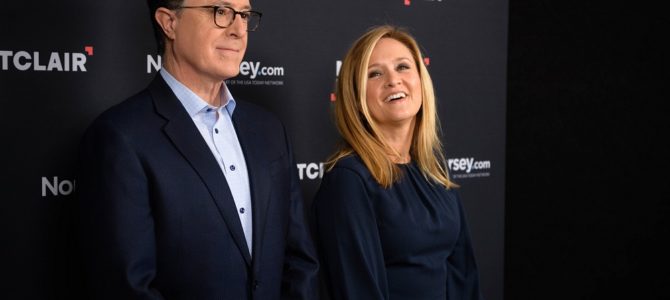
One-sided politics are killing late-night comedy, but maybe not in the way that you think. It is true that in recent years, with rare exception, late-night comedy talk shows have shifted their content from humor to propaganda for progressive politics.
While politics have always served as fodder for late-night monologues, it wasn’t until Jon Stewart politicized “The Daily Show” in the early 2000s that the idea of proclaiming political opinion as a comedian would be well received. Stewart invented the “Smart Liberal Comedian Host,” and today it seems as though every television network has its own version.
Stewart’s development of this brand, coupled with his confrontational interviews with members of the George W. Bush administration, also coincided with the dawn of the shareable Internet video. Stewart’s interviews and sharp-tongued monologues could be shared in bite-sized clips via email for the first time in history.
This negated the need to tune in to his actual broadcast. Stewart went from nerdy MTV VJ to a well-regarded, brilliant, politically minded comedian, supposedly brave enough to confront the conservative bureaucrats who dared appear on his show. He was the first comedian to use a comedy show to shout political ideology into an echo chamber and regard the applause he received as just as good as laughter.
However, in the 16 years Stewart hosted his show, he remained close to sixth or seventh place overall in late-night comedy programs, with only 1.7 million viewers at his peak, averaging closer to 1.5 million per episode. He may have been receiving critical praise, and he was the star of many progressives’ email inbox, but he never even came close to competing with Jay Leno or David Letterman, or even Jimmy Kimmel.
Small ‘Daily Show’ Viewership Splintered
Since Stewart left “The Daily Show,” the ratings have been much worse, not only because he was replaced by a less funny, less edgy comedian in Trevor Noah, but also because the already small audience that Stewart’s schtick appealed to was splintered. Almost a dozen shows were subsequently created in the image of Stewart’s politically heated take on comedy.
Since 1991, the year Johnny Carson retired from “The Tonight Show,” there have been an average of about 20 million viewers of various late-night comedy shows each night. Between 1992 and 2006, Leno and Letterman famously competed for ratings. During this period, Leno averaged about six million viewers per night, while Letterman averaged closer to four million.
With the invention of the DVR, Netflix, and inevitable host fatigue, both shows began a decline toward the end of the aughts that would eventually end their respective hosting duties.
Fallon took over “The Tonight Show” in 2014, and even in his best periods, and despite the praise he received for bringing in more of the highly coveted 18-49 demographic, he averages fewer than three million viewers a night.
After President Trump’s victory in 2016, there was quite a bit of noise about Steven Colbert holding the number-one spot among late-night comedy shows for 16 consecutive weeks thanks to his biting criticism of the newly elected president and providing a “safe space” for liberals each night. Yet, truthfully, even at the height of Colbert’s popularity, he was three million viewers short of Leno at the peak of his “Tonight Show” career.
Shrinking Audiences Plus Multiplying Shows
Despite the ever-shrinking audiences of each show, more of them keep getting produced. At a certain point in 2018, there were ten late-night comedy shows vying for a piece of the average 20 million viewers for their time slots. Thus, it was no surprise to see Netflix announce that “The Break With Michelle Wolf” would not be renewed due to low viewership. But they are releasing a show with fellow “Daily Show” alum Hasan Minhaj later this year.
Wolf and Minhaj are outspoken critics of Trump, and of conservative politics. Netflix already had a failed experiment with a similar concept hosted by Chelsea Handler that was canceled in 2017, but maybe the third time is the charm.
Samantha Bee recently told fellow comedian Rob Corddry that she felt like she was “teetering on the ledge of democracy” in response to him asking how things were going on her TBS show, “Full Frontal.” Corddry, who referenced this interaction during his interview for the “Pardon My Take” podcast, didn’t share Bee’s anxious sentiment.
He had been a correspondent at “The Daily Show” from 2002-2006, and recalled the joke-writing philosophy during his tenure as “The shortest route to the funniest joke. Issues be d-mned.” Although that philosophy did not make them the most popular show, it was enough to keep the viewership at “The Daily Show” close to 1.5 million viewers on a fairly consistent basis, despite their obvious political agenda.
Bee’s ratings haven’t been so static. In 2016 the show premiered to more than two million viewers, but struggled to find a regular audience, with most of that year coming in well under one million per episode. The presidential election and inauguration initially gave Bee a spike in viewers, but never more than 1.5 million. In 2018, only one episode drew one million or more.
These figures also only describe her total viewers. In the highly important and coveted 18-49 demographic, she’s down 34 percent since this time last year. She may be teetering on the ledge of democracy, but her message isn’t reaching very many people.
People Have More Choices, and Most Don’t Want This
The fact is, the idea that heavily biased political comedy shows appeal to enough people to make them viable is a fantasy. If the 1.7 million viewers Stewart attracted at the height of “The Daily Show” in 2008 was the model that encouraged so many spin-offs, it’s baffling to think about how their existence could be maintained with so few viewers spread over so many shows.
Even Conan O’Brian’s brief stint as host of “The Tonight Show,” which the network considered a huge failure and fired him from after less than one year, received an average of 3.2 million viewers.
The three current “heavyweights” of late-night comedy—Colbert, Fallon, and Kimmel—aren’t nearly funny or consistent enough to draw the numbers their predecessors did, especially when they insert their personal politics into their “comedy.” In the age of video on demand, people are far less likely to tune into an un-plotted chat show packed with commercials hosted by a sporadically funny comedian who has a high probability of preaching at them.
If late-night comedy shows have a chance of survival, they have to offer up a lot more than a half-baked political rant meant only for a minority of their target demographic.









